|
Feds List the Species as Threatened Due to Overfishing and Habitat Loss Washington, DC—As a result of WildEarth Guardians’ 2010 petition to protect the Nassau grouper (Epinephelus striatus), today the National Marine Fisheries Service (NMFS) announced it will list the species as “threatened” under the Endangered Species Act (ESA). NMFS identified historic and continued human exploitation, and inadequate protections from overfishing as primary threats to the species. “We’re thrilled to see the Nassau grouper take the first step on the road to recovery,” said Taylor Jones, endangered species advocate for WildEarth Guardians. “We call on the agency to more quickly respond to the threats to our oceans by providing protections for this and other imperiled marine species.” Nassau groupers live in coral reefs in the western North Atlantic from Bermuda, Florida, and the Bahamas to the Yucatan Peninsula and throughout the Caribbean to southern Brazil, including occasional sightings in the Gulf of Mexico. They can grow up to four feet in length and live up to 29 years. Nassau groupers follow the cycle of the moon. Though normally solitary reef-dwellers, they form large spawning aggregations, from a few dozen to historically over 100,000 individuals, on or near full moons between December and March. Unfortunately, these aggregations are vulnerable to intensive fishing since they are always in the same place at the same time. Often, the discovery of a spawning aggregation is followed by heavy exploitation, and the local population can disappear in as little as a few years. “Reining in human exploitation of Nassau grouper spawning aggregations is key to protecting these magnificent fish,” said Jones. “The agency should also designate critical habitat in the U.S. portions of the species’ range to protect the coral reefs and spawning sites these fish need to survive.” An estimated 50-80 percent of all life on earth is found in the oceans. More than half of marine species may be at risk of extinction by 2100 without significant conservation efforts. Despite this grave situation, the U.S. largely fails to protect marine species under the ESA. Of the 2,258 species protected under the Act, only 139 (~6 percent) are marine species. Recognizing the decline of ocean health, on July 22, 2010 President Obama issued an Executive Order requiring agencies, including the National Marine Fisheries Service, to “protect, maintain, and restore the health and biological diversity of ocean... ecosystems,” and to “use the best available science and knowledge to inform decisions affecting the ocean.” Guardians’ multi-species marine petition seeks to compel the Fisheries Service to live up to this mandate. Protection under the ESA is an effective safety net for imperiled species: more than 99 percent of plants and animals protected by the law exist today. The law is especially important as a defense against the current extinction crisis; species are disappearing at a rate much higher than the natural rate of extinction due to human activities. Scientists estimate that 227 species would have gone extinct by 2006 if not for ESA protections. Listing species with global distributions can both protect the species domestically, and help focus U.S. resources toward enforcement of international regulation and recovery of the species.
Nassau grouper. Photo: NOAA |
|
|
info@wildearthguardians.org | © WildEarth Guardians | Historical Archives | Privacy Policy

